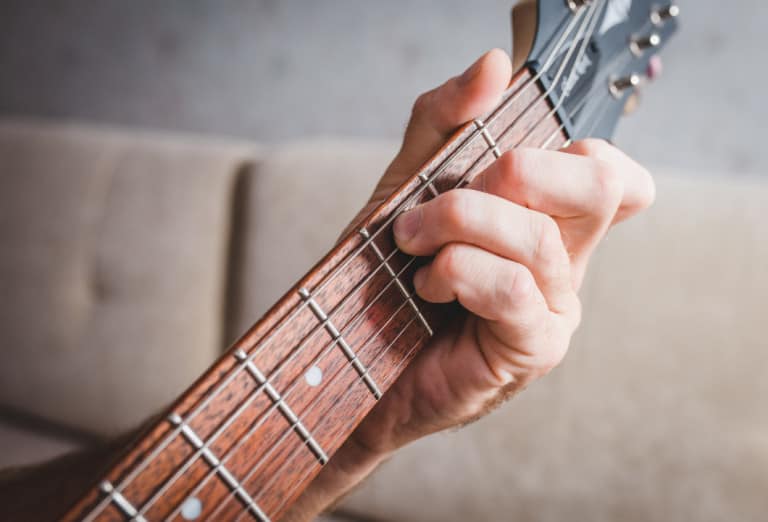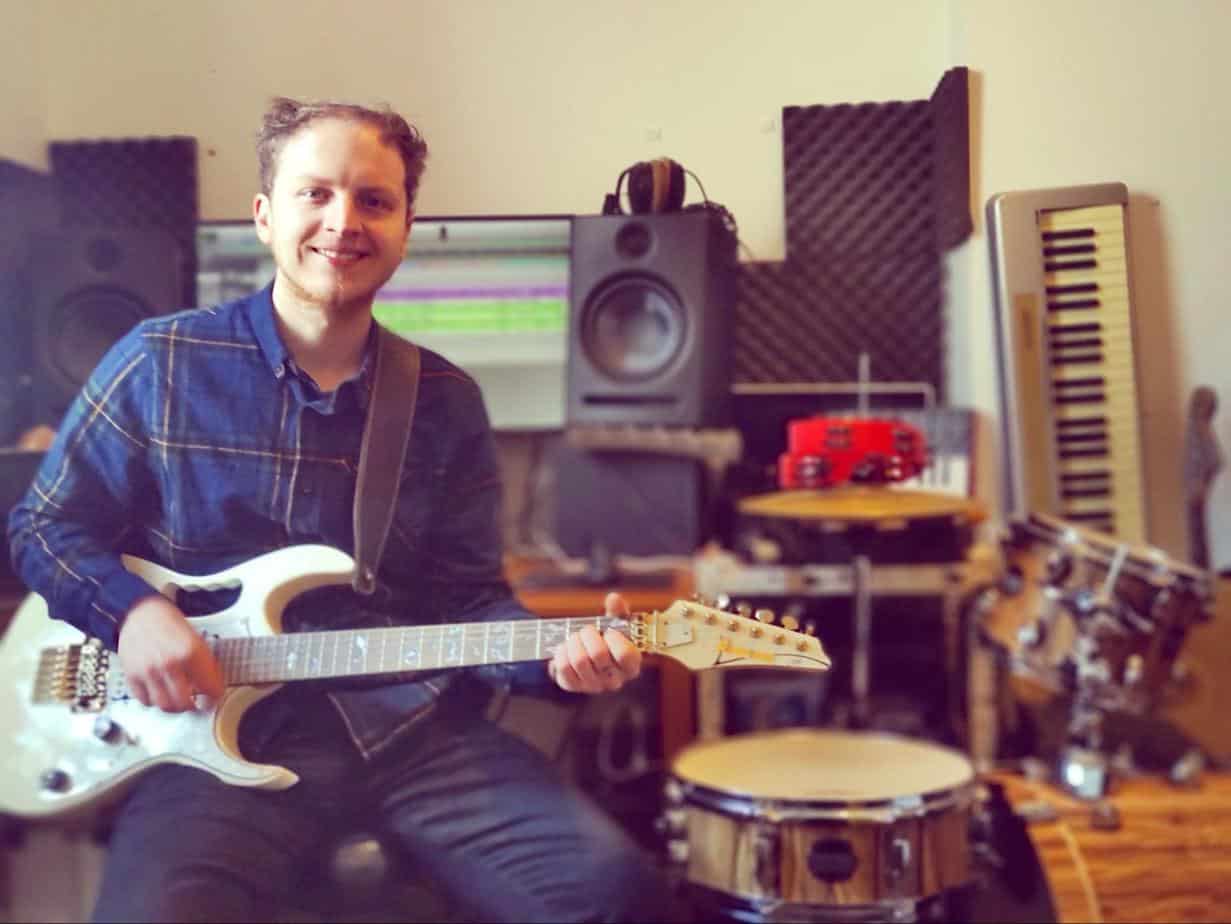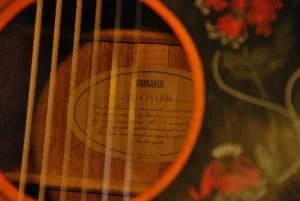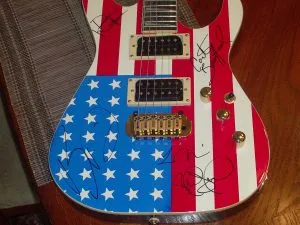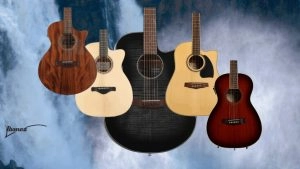The C7 guitar chord is an exciting variation of the standard C and brings an extra level of expression to your playing. With only a slight modification to the major shape, you can unlock a new colorful chord.
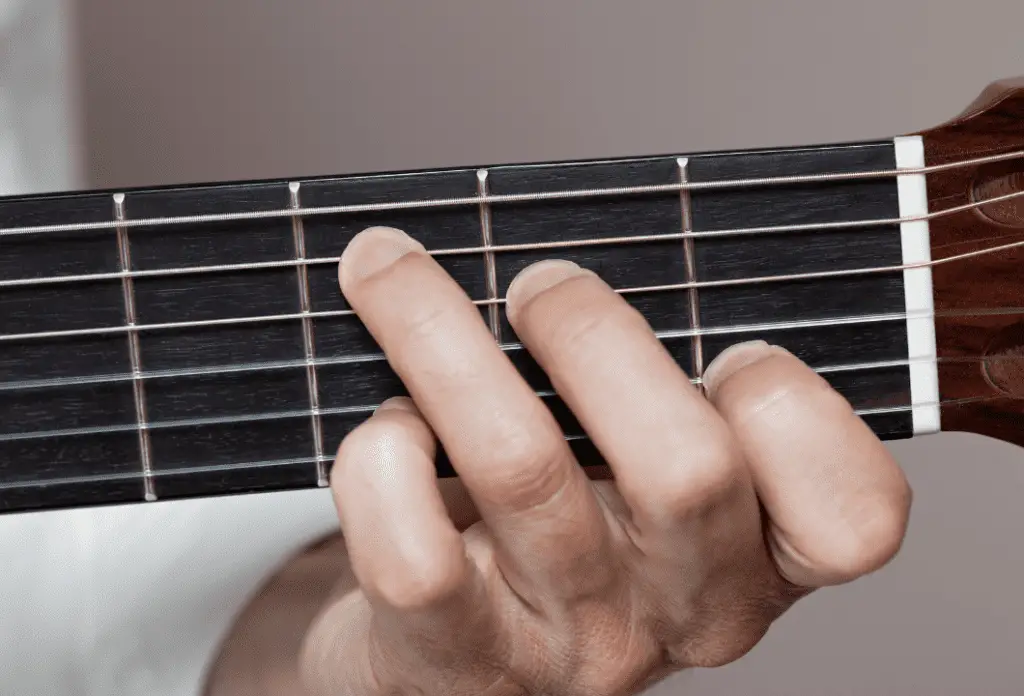
I’ve been playing guitar for years and I find the C7 guitar chord is a great way to expand your playing technique. There are many ways to play a C7 — this guide explores the core shapes and outlines a few extra variations of this basic chord.
We’ve also included a bunch of video tutorials on this page to help you learn more quickly. (Yes, it’s true. You can learn guitar from watching videos (1).
If you’re interested in learning guitar, we recommend taking online guitar lessons. We also previously covered how to shape an A chord.
• • •
Reading a Guitar Chord Chart
Before getting into a C7 guitar chord, you need to know how to read a chord chart for guitars. This will help you master any shape — and future chord progression — with ease.
The chart mimics a guitar fretboard and shows you the 6 strings. The left line is the low E string, the right line is the highest or 6th string (high E).
The numbers show which finger should be used to hold the string to that particular fret.
Starting with 1 being your index finger, 2 the middle, 3 the ring, and finishing on 4 the pinky. An ‘X’ indicates dead notes – these strings should be muted and not played in the chord. Strings with an ‘O’ above them indicate they are open strings, so they should be played without any fretting.
The horizontal lines represent the frets, with lower pitches at the top and higher pitches at the bottom. The chart can represent any area of the guitar neck, which will be indicated by numbers indicating which fret the diagram starts on.
• • •
C7 guitar Chord for Beginners
This section of the lesson explains how to make a few versions of the C7 Chord.
The theoretical difference of a C7 chord is that it includes a flattened 7th interval over the root.
C7 Guitar Chord in Open Position
This chart shows the finger pattern for a C7 guitar chord in the open position. The C7 only needs one extra finger fretting in comparison to a standard C chord.
The notes comprise the standard C major triad with an additional flattened 7th note. For a C7 guitar chord, this is C, E G, and Bb notes. The notes are mostly from the C major scale, except for the seventh note.
In terms of finger positions for this chord, start by putting your first finger on the first fret of the B string. Your second finger goes on the second fret of the third string, and your third finger goes on the third fret of the second string. This makes up a standard C major.
To complete a C7 guitar chord, simply place your fourth finger on the third fret of the fourth string.
All you need to do now is strum through it, switch between other chords, and play it enough to commit it to muscle memory. 7s are useful for blues guitar music, and this open position makes it super easy to transition between the C major and C7. All you need to do is add your 4th finger to the fourth string of a standard C major.
Next, let’s look at some other ways to play the C7 guitar chord. These voicings create a different tone and timbre due to the altered harmonic content from modified finger positions. Using them is a great way to add your unique touch to a song.
C7 Barre Chord (V1)
Barre chords are a highly useful technique, especially for fingerstyle guitar players. If you learn one chord shape it can be transferred across the rest of the frets, letting you quickly change the root note and tonality of the chord.
Barres take open chord shapes and move them around the guitar neck to achieve chords. The first finger is generally used to hold down all the strings on one fret, with the other 3 fingers creating the rest of the shape. Sometimes you need to mute some of the strings.
There are several shapes to play based on the precursor chord shapes. Each type has a different tone due to the placement along the frets. So there are a large number of barre versions of the C7 guitar chord.
One of the easiest shapes is the open A7 barred on the 3rd fret. This tends to be one of the most comfortable techniques and is also around the middle of the neck making it easy to transition to most other chords.
Take your index finger, drop it on the 3rd fret, fretting across all six strings. The second finger holds the 5th fret on the 3rd string, and the third finger holds the fifth fret of the 5th string.
Avoid hitting the low E String for a cleaner sound.
C7 Barre (V2)
A second version of the C7 chord in barre format uses the basic open E shape. This puts the root note of the chord on the 1st string. This is played on all six strings and is played with three fingers.
The first finger barres the 8th fret, with the middle finger being on the ninth fret of the 4th string, and the third finger holding the tenth fret of the 2nd string. All the other strings are left open to play.
You can easily transition to a standard major chord by putting holding the tenth fret of the D string
This C7 bar chord comes higher up the fretboard, and has a different tone and feel to the variation above.
C7 Minor
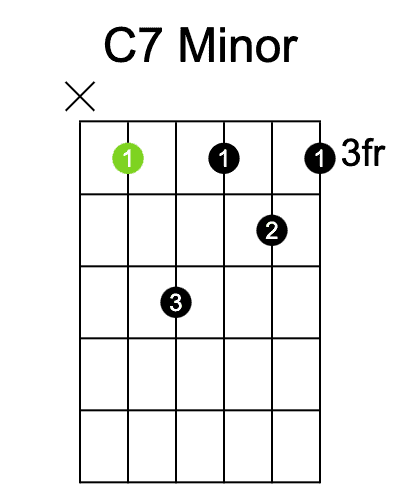
The minor C7 guitar chord is another useful alteration of the normal C7 guitar chord. This uses the base of a minor scale instead, which creates a darker, more ominous sound.
The easiest way to play the C7 minor chord is in barre format. There are several shapes for this C7 chord, but I think the Am7 shape is one of the most comfortable.
It’s very similar to the C7 barre V1 above, except you slide the second finger one fret closer to the nut.
• • •
Common Problems With the C7 Guitar Chord
There are a couple of common pitfalls that new players experience when playing the C7 guitar chord. Here are some useful guitar tips that will help you pull this chord off in style.

When you play make sure to keep the frettings clean, avoid accidentally muting strings with other fingers. The pinky finger is often the culprit here and is prone to muting the strings below it without the proper grip. This can be prevented by getting a good wrist position, and arching your pinky as much as you can.
When barring chords, be sure to create enough pressure with your index finger across every string. Let the right notes ring clearly and ensure others are not unnecessarily muted or buzzing. It can take a while to get the strength built up in your first finger so practice regularly to increase muscle!
These issues are best solved through practice and by taking lessons. We also recommend adding a finger strengthener to your guitar accessories bag.
• • •
Frequently Asked Questions
How should I start practicing the C7 Guitar Chord?
First, look at a few of the chord shapes, and pick one that looks easy to learn for you. Get used to holding the chord, and transitioning in/out with other chords. After you’ve got the grip of one shape, switch it up and try a different one. Another good technique is to practice songs that use the C7 chord.
Is a Barre C7 Guitar Chord easier than the open shape?
I would say yes because the finger work is a little less complicated in the barre chord. The open chord requires a little more dexterity, and I find the shape a bit fiddlier to hold. Although many people do find the open chord easier.
I tend to prefer barres in general, just out of convenience more than anything. A
Is there a trick to barre chords?
If you can master barre chords you will connect with the guitar on a much deeper level. It makes it a lot easier to express yourself on the guitar.
The main trick to learning is learning the fretboard. You should practice moving the shapes across the fretboard. The caged system often helps with navigating the fretboard with ease.
Another key learning is a wide range of barre shapes. This gives you a wider range of styles and voicings.
What’s the difference between the C chord and a C7 guitar chord?
C and C7 are two guitar chords that are very similar to one another. They both have the same notes and they sound almost the same, but there is a slight difference in the way they are played.
The C chord is made up of three notes: C, E, G. When playing this chord on a guitar, you will need to use your first finger for the note E and your second finger for G. The third finger can be used for any other note or string on the guitar.
How can I master guitar chords?
The key is to play regularly and take as many lessons as you can. We included some video lessons here which you can use as a free course, although you can also see our list of the best online guitar lessons.
What’s a dominant chord?
If you are wondering ‘what is a dominant chord?’ Don’t worry, because many people ask the same thing.
A dominant chord is a major chord with the root in the fifth degree of a major or minor scale. If you add a flat 7th to it, you have a “dominant 7th chord.” Therefore, the C7 chord you just learned is a specific instance of a dominant 7th chord, and also goes by the name of “C Dominant 7.”
The term “dominant” originally comes from the musical idea of harmonic tension and release. The dominant releases tension by moving to its tonic resolution in the key. In other words, if you play a C Dominant 7, its sound will make you feel a tension that will only be relieved when you play an F chord.
As an example, this diagram shows you how to make a C Dominant 7 chord. As you may have noticed, its fingering is exactly the same as the C7 barre chord above. Of course, both the barre V2 and open C7 classify as C Dominant 7 chords as well.
• • •
I’ll ‘C’ you in the practice room!

Get practicing these shapes and you will be rocking a C7 guitar chord in no time. Whether you are more into rhythm playing or solos, the C7 guitar chord is a staple for all kinds of music. Keep practicing and coming back here for more guitar tips!
References
- Yackulic Khristopher, “Can You Learn How to Play Guitar with Mobile Apps and Streaming Servies?” as published here: https://www.androidheadlines.com/2022/02/can-you-learn-how-to-play-guitar-with-mobile-apps-streaming.html

